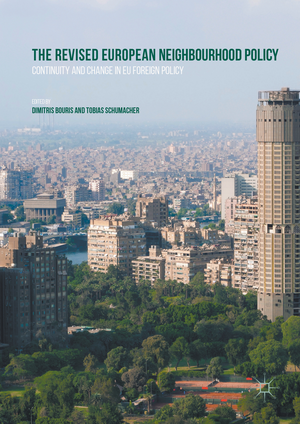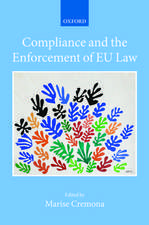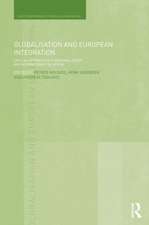The Revised European Neighbourhood Policy: Continuity and Change in EU Foreign Policy
Editat de Dimitris Bouris, Tobias Schumacheren Limba Engleză Hardback – 17 noi 2016
| Toate formatele și edițiile | Preț | Express |
|---|---|---|
| Paperback (1) | 695.85 lei 6-8 săpt. | |
| Palgrave Macmillan UK – 6 mar 2018 | 695.85 lei 6-8 săpt. | |
| Hardback (1) | 947.85 lei 6-8 săpt. | |
| Palgrave Macmillan UK – 17 noi 2016 | 947.85 lei 6-8 săpt. |
Preț: 947.85 lei
Preț vechi: 1155.91 lei
-18% Nou
Puncte Express: 1422
Preț estimativ în valută:
181.39€ • 188.23$ • 151.61£
181.39€ • 188.23$ • 151.61£
Carte tipărită la comandă
Livrare economică 17-31 martie
Preluare comenzi: 021 569.72.76
Specificații
ISBN-13: 9781137471819
ISBN-10: 1137471816
Pagini: 272
Ilustrații: XVII, 306 p.
Dimensiuni: 148 x 210 x 25 mm
Greutate: 0.51 kg
Ediția:1st ed. 2016
Editura: Palgrave Macmillan UK
Colecția Palgrave Macmillan
Locul publicării:London, United Kingdom
ISBN-10: 1137471816
Pagini: 272
Ilustrații: XVII, 306 p.
Dimensiuni: 148 x 210 x 25 mm
Greutate: 0.51 kg
Ediția:1st ed. 2016
Editura: Palgrave Macmillan UK
Colecția Palgrave Macmillan
Locul publicării:London, United Kingdom
Cuprins
Acknowledgements.- Notes on Contributors.- Introduction 1. The 2011 Revised European Neighbourhood Policy: Continuity and Change in EU Foreign Policy; Tobias Schumacher and Dimitris Bouris.- PART I: The Revised European Neighbourhood Policy – Methodological, Conceptual and Empirical Challenges.- 2. Research Design in the Study of the Revised European Neighbourhood Policy; Theofanis Exadaktylos and Kennet Lynggaard.- 3.Deconstructing the ‘Ideal Power Europe’ Meta-Narrative in the Revised European Neighbourhood Policy; Münevver Cebeci.- 4.The EU’s Regional Normative Hegemony Encounters Hard Realities: The Revised European Neighbourhood Policy and the Ring of Fire; Hiski Haukkala.- PART II: Legal and Institutional Aspects of the Revised European Neighbourhood Policy.- 5. Continuity and Change in the Legal Relations between the EU and its Neighbours: A Result of Path-dependency and Spill-over Effects; Peter Van Elsuwege and Guillaume Van der Loo.- 6.The EEAS and the Revised European Neighbourhood Policy: What Institutional Balance?; Hrant Kostanyan.- 7. The European Parliament and the Revised European Neighbourhood Policy; Joanna Kaminska.- PART III: The Revised European Neighbourhood Policy, Conflicts and Crises in the Neighbourhood.-8.The Revised European Neighbourhood Policy and Conflicts in the South Caucasus: The EU’s Growing Conflict Transformation Role; Sabine Freizer.- 9.The EU and Crisis in Ukraine: Policy Continuity in Times of Disorder?; Michal Natorski.- 10. The Revised European Neighbourhood Policy and the EU’s Comprehensive Approach towards the Israeli-Palestinian Conflict: Not so New, after All; Patrick Müller.- 11. The EU, the European Neighbourhood Policy and the Western Sahara conflict: executive continuity and parliamentary detours; Irene Fernández-Molina.- PART IV: The Revised European Neighbourhood Policy and Sectoral Cooperation .- 12.Energy Cooperation:The Leading Light of the Revised European Neighbourhood Policy? Drivers and Limits of the EU’s Functionalist Extension; Anna Herranz-Surrallés.-13. Cooperation on Migration and the Revised European Neighbourhood Policy; Agnieszka Weinar.- Conclusion 14. Plus ça Change, Plus C’est la Même Chose? The European Neighbourhood Policy and Dynamics of Internal and External Change; Laure Delcour.- Index.
Notă biografică
Dimitris Bouris is Assistant Professor at the Department of Political Science, University of Amsterdam, the Netherlands. He is also Associate Research Fellow at the European Neighbourhood Policy Chair at the College of Europe (Natolin). He is the author of The European Union and Occupied Palestinian Territories: State-building without a State (2014) for which he was selected as Politics and International Relations author of the month for February 2014.
Tobias Schumacher is Chairholder of the European Neighbourhood Policy Chair at the College of Europe (Natolin), Poland. He is also an Associate Senior Research Fellow at the Center for International Studies (CES) at the Lisbon University Institute (ISCTE-IUL) and in the first half of 2016 was a John F. Kennedy Memorial Fellow at the Minda de Gunzburg Center for European Studies at Harvard University.
Tobias Schumacher is Chairholder of the European Neighbourhood Policy Chair at the College of Europe (Natolin), Poland. He is also an Associate Senior Research Fellow at the Center for International Studies (CES) at the Lisbon University Institute (ISCTE-IUL) and in the first half of 2016 was a John F. Kennedy Memorial Fellow at the Minda de Gunzburg Center for European Studies at Harvard University.
Textul de pe ultima copertă
This book analyses the revised European Neighbourhood Policy (ENP) which entered into force in May 2011, thereby replacing its predecessor of 2003/2004. The edited volume provides a structured and comprehensive overview of the most recent developments in EU foreign policy (EUFP) towards the EU’s southern and eastern neighbourhood through the prism of continuity and change. Topics covered include: conceptual, theoretical and methodological issues; the legal and institutional aspects of the revised ENP and the changes brought by the entering into force of the Lisbon Treaty; and conflicts and crises in the EU’s neighbourhood, such as the Western Sahara conflict, the Israeli-Palestinian conflict, the South Caucasus conflicts and the crisis in Ukraine. The authors also focus on sectoral cooperation, analysing the changes brought by the revised ENP of 2011 in the domains of energy cooperation and migration. This volume will appeal to scholars and upper level students in EU/European Studies, International Relations, Political Science, as well as practitioners and policy-makers in the field.
Caracteristici
Considers the effects of the most recent ENP ruling on EU foreign policy, in light of recent unrest and continued political and humanitarian crises in Central Asia, the Middle East and North Africa Provides a broad analysis that goes beyond just one single-issue area Adopts a dual geographical angle that allows for the incorporation of both the southern and eastern neighborhood into its analysis















